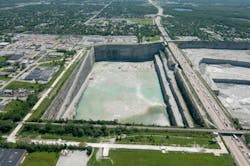MWRD, Officials Cut Ribbon on Thornton Composite Reservoir
Dubbed the "Grand Canyon of the South Suburbs," the Thornton Composite Reservoir presents a larger than life view from above with a larger than life purpose for the region. Now connected to a tunnel system and prepared to hold up to 7.9 billion gal of water, the reservoir will reduce flooding in the area while preventing pollution in Chicago area waterways.
Officials with the Metropolitan Water Reclamation District of Greater Chicago (MWRD) unveiled this latest engineering feat alongside U.S. Sen. Dick Durbin, U.S. Rep. Robin Kelly, U.S. Rep. Mike Quigley, U.S. Environmental Protection Agency (EPA) Region 5 Administrator Susan Hedman, U.S. Army Corps of Engineers Lt. Col. Kevin Lovell, state Sen. Napolean Harris, Illinois EPA Director Lisa Bonnett, and other elected and community leaders.
"To the naked eye, it's a gigantic hole in the ground surrounded by 400 million-year-old limestone rock, but to the people who live in the surrounding communities it symbolizes hard work, diligence and hope for a better tomorrow in our pursuit to mitigate flooding and clean our waterways," Durbin said.
The reservoir, tantamount to 12 Soldier Fields in size, is part of the MWRD's Tunnel and Reservoir Plan (TARP), also known as the "Deep Tunnel," consisting of more than 100 miles of tunnels deep below the surface of the Chicago region and three reservoirs designed to capture and hold storm water and sewage for treatment at water reclamation plants. Together with the Thornton Reservoir, the Gloria Alitto Majewski Reservoir (350 million gal) in the northwest suburbs, the yet to be completed McCook Reservoir (10 billion gal) in the west suburbs, and 109 miles of tunnels (2.3 billion gal), TARP will accommodate for 20.55 billion gal of water.
The Thornton Composite Reservoir will benefit 556,000 people in 14 communities throughout the south side of Chicago and south suburbs. It will protect 182,000 homes, businesses and other facilities and improve water quality in the Calumet Rivers and Calumet-Sag Channel by collecting combined sewer overflows before entering waterways. The new reservoir's capacity holds these overflows before pumping the water back to the Calumet Water Reclamation Plant to be treated.
Through an agreement reached in 1998, the MWRD asked Hanson Material Services to create the rough hole needed for the reservoir. The deal would also allow Hanson to sell the rock through their existing Thornton Quarry, which dates back to the 1860s. That aggregate is used in several area road and building construction projects.
"Our 2013 Consent Decree requires MWRD to triple existing combined sewer overflow storage by expanding capacity at the Thornton and McCook reservoirs by 2017," Hedman said. "The new Thornton Reservoir is even larger than required by the settlement—and will prevent billions of gallons of sewage from overflowing into Lake Michigan and Chicago area rivers during heavy rainstorms."
Beyond mining the large reservoir, the other challenge was properly sealing the reservoir to contain the water much like a bathtub. A dam, made of 32,000 cu yards of roller compacted concrete, was constructed below the Tri-State Tollway to separate the reservoir and its contained water from reaching the main lobe of the quarry. Two mining haul tunnels at lower elevations were also plugged with concrete.
At the bottom of the reservoir is an impermeable natural layer of shale existing approximately 500 feet below ground, preventing water from leaving through the bottom of the reservoir. To keep water from escaping through the sides of the reservoir, a double-row grout curtain was installed around the outside perimeter of the hole and tied into the layer of shale. From the surface, holes were drilled as far down as 500 feet deep at a 15-degree angle and then filled in stages from the bottom up with grout under pressure. The grout then migrated into all of the cracks and fissures in the rock mass to reduce the permeability. The holes were drilled about every five feet around the nearly two-mile perimeter of the reservoir. A second row was then constructed about 20 feet away, angled in the opposite direction in an attempt to intercept and seal as many cracks as possible.
The total cost of TARP is $3.8 billion, about half of which came from federal money. The total cost of Thornton is projected at $429 million.
Solar-powered aerators were installed at the bottom of the reservoir. These will float up and down with the water elevation, keeping the surface layer of water from going septic and causing any odors.
Lastly, the reservoir was connected with the tunnel system by removing a 10-ft, thick concrete mass that operates as a plug. The tunnel runs about 1,300 ft before meeting up with the existing, operational deep tunnels. A concrete apron was constructed in front of the tunnel to withstand the force of the water coming out of the tunnel, which can be at velocities of up to 30 ft per second. The apron will prevent erosion of the stone reservoir floor.
Source: Metropolitan Water Reclamation District of Greater Chicago
